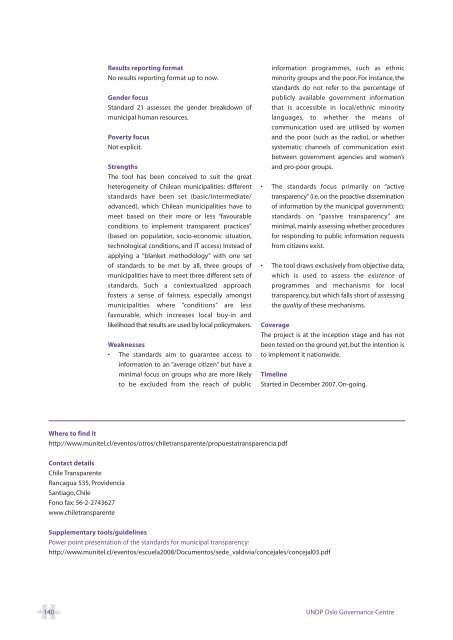A Users' Guide to Measuring Local Governance
A Users' Guide to Measuring Local Governance
A Users' Guide to Measuring Local Governance
Create successful ePaper yourself
Turn your PDF publications into a flip-book with our unique Google optimized e-Paper software.
Results reporting format<br />
No results reporting format up <strong>to</strong> now.<br />
Gender focus<br />
Standard 21 assesses the gender breakdown of<br />
municipal human resources.<br />
Poverty focus<br />
Not explicit.<br />
Strengths<br />
The <strong>to</strong>ol has been conceived <strong>to</strong> suit the great<br />
heterogeneity of Chilean municipalities: different<br />
standards have been set (basic/intermediate/<br />
advanced), which Chilean municipalities have <strong>to</strong><br />
meet based on their more or less “favourable<br />
conditions <strong>to</strong> implement transparent practices”<br />
(based on population, socio-economic situation,<br />
technological conditions, and IT access) Instead of<br />
applying a “blanket methodology” with one set<br />
of standards <strong>to</strong> be met by all, three groups of<br />
municipalities have <strong>to</strong> meet three different sets of<br />
standards. Such a contextualized approach<br />
fosters a sense of fairness, especially amongst<br />
municipalities where “conditions” are less<br />
favourable, which increases local buy-in and<br />
likelihood that results are used by local policymakers.<br />
Weaknesses<br />
• The standards aim <strong>to</strong> guarantee access <strong>to</strong><br />
information <strong>to</strong> an “average citizen” but have a<br />
minimal focus on groups who are more likely<br />
<strong>to</strong> be excluded from the reach of public<br />
information programmes, such as ethnic<br />
minority groups and the poor. For instance, the<br />
standards do not refer <strong>to</strong> the percentage of<br />
publicly available government information<br />
that is accessible in local/ethnic minority<br />
languages, <strong>to</strong> whether the means of<br />
communication used are utilised by women<br />
and the poor (such as the radio), or whether<br />
systematic channels of communication exist<br />
between government agencies and women’s<br />
and pro-poor groups.<br />
• The standards focus primarily on “active<br />
transparency” (i.e. on the proactive dissemination<br />
of information by the municipal government);<br />
standards on “passive transparency” are<br />
minimal, mainly assessing whether procedures<br />
for responding <strong>to</strong> public information requests<br />
from citizens exist.<br />
• The <strong>to</strong>ol draws exclusively from objective data,<br />
which is used <strong>to</strong> assess the existence of<br />
programmes and mechanisms for local<br />
transparency, but which falls short of assessing<br />
the quality of these mechanisms.<br />
Coverage<br />
The project is at the inception stage and has not<br />
been tested on the ground yet, but the intention is<br />
<strong>to</strong> implement it nationwide.<br />
Timeline<br />
Started in December 2007. On-going.<br />
Where <strong>to</strong> find it<br />
http://www.munitel.cl/even<strong>to</strong>s/otros/chiletransparente/propuestatransparencia.pdf<br />
Contact details<br />
Chile Transparente<br />
Rancagua 535, Providencia<br />
Santiago, Chile<br />
Fono fax: 56-2-2743627<br />
www.chiletransparente<br />
Supplementary <strong>to</strong>ols/guidelines<br />
Power point presentation of the standards for municipal transparency:<br />
http://www.munitel.cl/even<strong>to</strong>s/escuela2008/Documen<strong>to</strong>s/sede_valdivia/concejales/concejal03.pdf<br />
140 UNDP Oslo <strong>Governance</strong> Centre








![GuÃa del Usuario ] - Governance Assessment Portal](https://img.yumpu.com/44740603/1/190x253/gua-a-del-usuario-governance-assessment-portal.jpg?quality=85)







